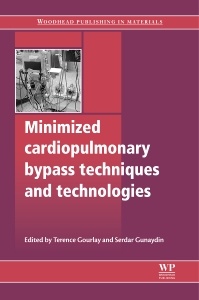Minimized Cardiopulmonary Bypass Techniques and Technologies Woodhead Publishing Series in Biomaterials Series
Coordonnateurs : Gourlay Terence, Gunaydin Serdar

Part one covers the broad range of CPB pathophysiology, including anticoagulant protocols, the impact of CPB circuit surfaces, optimal haemodilution levels, and the important issue of CPB-induced systemic inflammatory response syndrome. Part two focuses on the issues of the new equipment developed for mini-CPB, optimal myocardial protection protocols and CPB perfusate options. Part three discusses clinical issues, including patient selection, coronary and valve surgery protocols and, among others, paediatric patients.
With its distinguished editors and international team of expert contributors, Minimized cardiopulmonary bypass techniques and technologies is a valuable reference for cardiac surgery teams and those researching this important technology.
Contributor contact details
Foreword
Chapter 1: Historical development of minimised cardiopulmonary bypass
Abstract:
1.1 Introduction and historical perspective
1.2 Cardiopulmonary bypass: from pioneering to refinement
1.3 Cardiopulmonary bypass: does size matter?
1.4 Conclusions
Chapter 2: Anticoagulation protocols for minimized cardiopulmonary bypass
Abstract:
2.1 Introduction: blood activation during cardiac surgery with cardiopulmonary bypass (CPB)
2.2 Anticoagulation during CPB: basic principles and historical notes
2.3 Heparin-bonded surfaces and other biocompatible treatments
2.4 Reduced systemic heparinization (RSH)
2.5 Contraindications
2.6 Future trends
Chapter 3: Minimized extracorporeal circulation: physiology and pathophysiology
Abstract:
3.1 Introduction: basic principles
3.2 The inflammatory cascade and biomarkers
3.3 Conclusions
Chapter 4: Blood–surface interface in miniaturised extracorporeal circulation systems
Abstract:
4.1 Introduction
4.2 Blood–surface contact in cardiopulmonary bypass (CPB)
4.3 Clinical benefits of miniaturised extracorporeal circulation systems
Chapter 5: Hemodilution: physiology and pathophysiology
Abstract:
5.1 Introduction
5.2 Basic physiology and pathophysiology of hemodilution
5.3 Microvascular alterations with hemodilution
5.4 Hemodilution and cardiopulmonary bypass (CPB)
5.5 Determinants of tissue oxygenation – functional capillary density (FCD)
5.6 Conclusions
Chapter 6: Inflammatory response and minimized cardiopulmonary bypass
Abstract:
6.1 Introduction
6.2 Cardiopulmonary bypass (CPB)-induced inflammatory cascade
6.3 Pharmacological antioxidants for CPB: impact on biochemical and clinical outcomes
6.4 Minimized CPB circuits
6.5 Acknowledgements
6.7 Appendix: abbreviations
Chapter 7: Design and principles of the minimized extracorporeal circuit
Abstract:
7.1 Introduction
7.2 Basic principles of minimized extracorporeal circulation
7.2 Evolution of minimized circuits
7.4 Minimized extracorporeal systems currently available
7.5 Surgical applications of minimized extracorporeal circulation
7.6 Controversies and challenges facing minimized cardiopulmonary bypass
7.7 Future trends in minimized cardiopulmonary bypass
Chapter 8: Cardiopulmonary bypass perfusate
Abstract:
8.1 Introduction
8.2 Crystalloid primes
8.3 Types of crystalloids and colloid agents used in prime
8.4 Pharmacological agents used in prime
8.5 Using prime in CPB procedures
8.6 Examples of prime combinations
8.7 Minimizing the use of prime
8.8 Conclusions
Chapter 9: Myocardial preservation techniques for mini-bypass
Abstract:
9.1 Introduction
9.2 Methods of myocardial protection
9.3 Myocardial protection in mini-bypass
9.4 Conclusion
Chapter 10: Minimised cardiopulmonary bypass: objectives and indications
Abstract:
10.1 Introduction: objectives of minimised cardiopulmonary bypass
10.2 Indications and patient selection
10.3 Future trends
Chapter 11: Coronary artery bypass grafting (CABG)
Abstract:
11.1 Introduction
11.2 History of coronary artery bypass grafting (CABG)
11.3 Patient selection (indications) for mini-invasive cardiopulmonary bypass
11.4 Conduits
11.5 Anastomoses techniques
11.6 Surgical management on mini-invasive cardiopulmonary bypass
11.7 Conclusions
Chapter 12: Valve surgery using minimized perfusion circuits
Abstract:
12.1 Introduction
12.2 Surgical and technical aspects
12.3 Blood management and patient treatment in valve surgery
12.4 Experience with closed-loop perfusion circuits in valve surgery
Chapter 13: Minimising cardiopulmonary bypass in children
Abstract:
13.1 Introduction
13.2 Challenges of cardiopulmonary bypass (CPB) in the congenital patient
13.3 Potential goals of mini-CPB
13.4 Mini-CPB and neurological outcome
13.5 Mini-CPB circuit design options in congenital heart surgery
13.6 Clinical trials
13.7 Alternative procedures to CPB
13.8 Conclusions
13.10 Appendix: abbreviations
Chapter 14: Comparison of minimized circulation with off-pump coronary artery bypass (OPCAB) grafting and conventional surgery
Abstract:
14.1 Introduction
14.2 Controversies and challenges facing off-pump coronary artery bypass (OPCAB) grafting
14.3 Studies comparing OPCAB with mini-cardiopulmonary bypass (mini-CPB) and mini-CPB assisted OPCAB
14.4 Future trends and competition between OPCAB and minimized cardiopulmonary bypass
Chapter 15: Minimally invasive cardiac surgery, port-access and robotic surgery
Abstract:
15.1 Introduction
15.2 Minimally invasive coronary artery bypass grafting
15.3 Minimally invasive valve surgery
15.4 Minimally invasive congenital surgery
15.5 Minimally invasive treatment of atrial fibrillation
15.6 Miscellaneous possibilities of minimally invasive surgery
15.7 Robotic surgery
15.8 Conclusions
Index
Dr Gunaydin currently serves as a faculty and clinical professor in the Department of Cardiovascular Surgery in Ankara City Hospital Campus, University of Health Sciences, Turkey. He studied histology and embryology and received PhD in Biomaterial Sciences in Tokyo Heart Institute, Japan. He is the Vice President for International Society of Minimally Invasive Extracorporeal Circulation (MiECTIS) and General Secretary of Turkish Enhanced recovery After Surgery (ERAS) Society. He also works as the scientific board member in Giganode Foundation and Heart Team Education Association. He directs international scientific projects on clinical evaluation and biomaterial confirmation of novel cardiopulmonary bypass-related technologies based on the prevention of inflammatory response, patient blood management and ERAS.
- Covers a broad range of cardiopulmonary bypass (CPB) pathophysiology, including anticoagulant protocols, the impact of CPB circuit surfaces and optimal haemodilution levels
- Focuses on new equipment specially developed for minimized-CPB and myocardial protection protocols
- Discusses clinical issues, including patient selection
Date de parution : 04-2012
Ouvrage de 272 p.
15.5x23.3 cm
Épuisé
